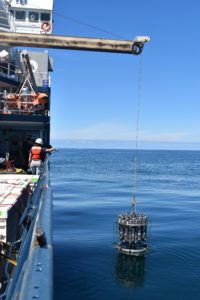
August 15th, 2025
It has finally arrived; the last day on the boat. We arrived in port today at around 10am, drifting through the channel under the bridge, the skies cloudy and dumping misty rain onto our heads. The sounds and smells of the land were somehow both refreshing and almost unsettling, especially when you realize how long it has been without seeing any trees or hearing birds. The rain and fog honestly felt nice despite how it left my clothes damp since it made for a more peaceful ambience as we headed towards the shore; pretty much the opposite of when we left.
As soon as we docked, the process of unloading began. While cranes were being operated carrying the larger equipment off, the rest of us began our own cleaning in workspaces and rooms. In a matter of minutes, the ship went from rather quiet to bustling with dozens of people racing around with preparations. It doesn’t feel like less than two weeks would have been long enough to have felt settled and yet this process of taking it all apart has felt strange. It feels odd when your biggest worries of the day go from “am I awake in time for my shift” to “how do I shove everything back into the bags I brought with 10x less energy than I had when I first packed them”.
As the reality of going to port and the imminent departure that is coming tomorrow has set in, a lot of emotions have come along with it. When I began this cruise and even before it had started, I wasn’t sure how it was going to turn out. I had fears of messing everything up, being late, getting in the way, getting seasick, etc. But as time passed, my fears quickly dissipated and ended up turning into a level of excitement I hadn’t felt before. Being able to do so many different things on the ship and learning so many lessons about ship life, research, technology, and even myself as a person has been amazing.
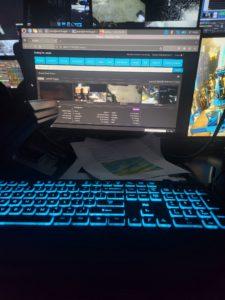
Learning everything from how to take chlorophyll and nutrient samples, how Jason is operated and navigating how to log a dive, to how the ship is powered, what it looks like to be a chef on a boat, and the different parts to a ship, I have gained so much knowledge in such a short time. All of these things have taught me important lessons and while I may not have been perfect at everything (I still cannot wrap my mind around a bowline knot despite it being taught to me by 5 separate people), I think I have learned how to be flexible, adjust, and adapt to things thrown my way much better than before.
Of course, nothing has made this trip more incredible than all the people who have helped us through it. The crew, who welcomed us onto their boat with open arms, asking us how our days were and answering every question we asked of them, the RCA science/APL team who showed us a look into their research and allowed us to help along the way, and the student ambassadors who took so much time to train us, answer questions, check in on us, and help whenever we needed, this group of people has been amazing to work with.
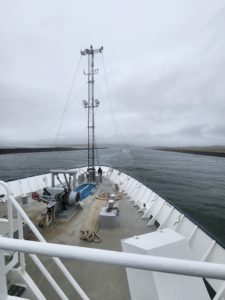
In conclusion, this has been one of the best experiences of my life so far and has inspired me to continue working as hard as I can to hopefully someday be able to do work on ships like these again. And while it may be sad to leave now, I do think that it is a good problem to have that instead of being excited to leave, I am already looking forward to the next chance I can get to go on a vessel like this. I am grateful to have been given this opportunity, and I plan to take every lesson I have learned with me as we not only head back on to shore but also through my career path ahead of me.
The start of today ended up unfortunately far more eventful than anyone would have liked. At around 7pm yesterday everyone was prepped to finally do the CAMDS replacement that had been delayed because of weather. Everything looked good, Jason was lifted over the deck, the undervator placed and latched, and then they entered the water smoothly. But just as we got comfortable, the van got a message over the radio that something was off. Because of the presence of the undervator, Jason couldn’t descend the usual way, leaving more slack in the line. At first the crew didn’t seem worried, just a bit more attentive than usual. The mood shifted suddenly though as several shiny bubbles began to appear. Debates of whether they should continue on with the dive or not filled the van for a couple of minutes. That was, until it was determined that the bubbles were likely leaking oil caused by damage from the slack in the line. This was only further confirmed when they attempted to check the brow camera only to find it was, as one person put it, “smoked”.
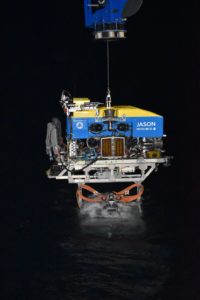
After a quick retrieval, the Jason team dove straight into action. In a whirlwind of planning, rebuilding, and coordinating, they managed to fix the issue in a matter of hours, a task that I feel would have taken days on land. This display of work ethic and talent was really inspiring to watch because despite initial frustrations, the team didn’t skip a beat and immediately went to work fixing as fast and as efficiently as possible. That determination is one of the things I have admired most about the environment on this trip, when something doesn’t go to plan no one gives up or gets really angry. They take a moment, breathe, access, and re-try with an effort I have never seen before, and it really inspires me to go after my own projects with a similar fervor.
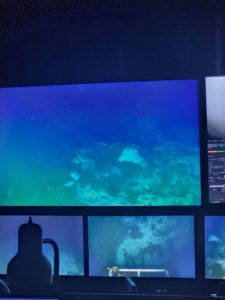
At around 3am, the dive was finally ready to start back up with a few adjustments for time. Once everyone had breathed a sigh of relief as Jason successfully entered the water, I only had an hour left in my shift, so I settled in for a rather short time at the Sea Logging seat. Once my shift had ended and we switched out to the next people, I found that my adrenaline was keeping me from feeling sleepy. And so, I ended up staying up for another 4 hours until it was breakfast time, which left my total hours awake at 22 when 8am rolled around. Somehow I still wasn’t sleepy until after breakfast but let’s just say, as soon as my head hit the pillow, I felt like I was made of stone that could not move.
Today being our last official full day on the boat was very bittersweet. Knowing that soon I would be going back home to my cats and my family was very happy, however also realizing that going meant leaving all of this behind made it also quite sad. I attempted to not let this get me down though and spent most of the day finding work including helping Lacie take more Niskin samples, logging for another simple 2 hour dive, and helping with some screws on an underwater camera. We also saw some dolphins that rode along in the wake of the Atlantis, jumping and skipping across the waves until they got bored and meandered away.
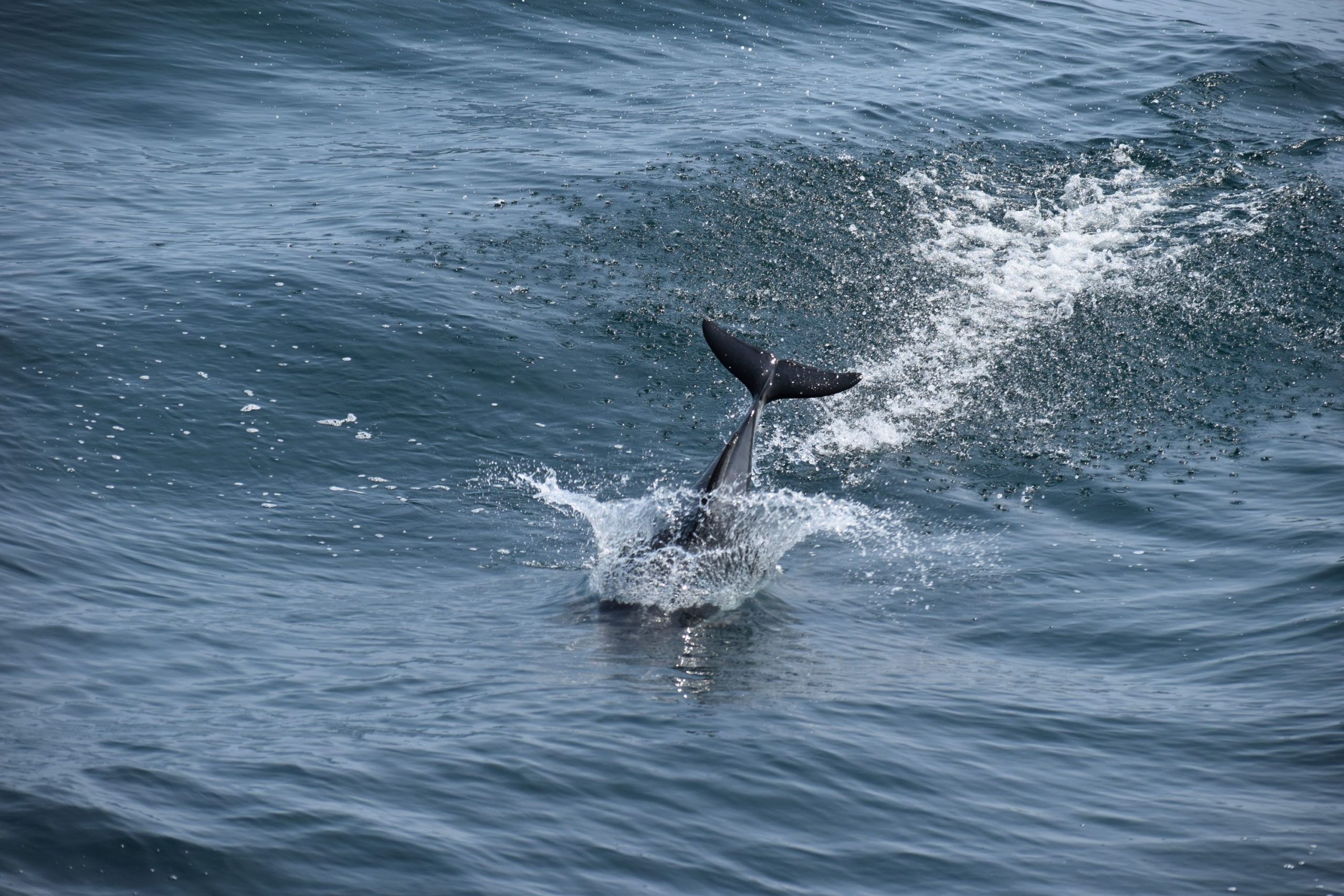
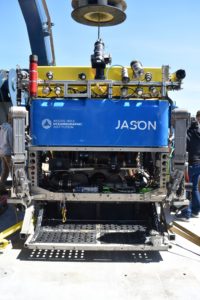
One of the most exciting things we have been given the chance to do happened at Southern Hydrate ridge yesterday where one of the Jason pilots Akel, allowed the Visions students in the van to actually drive Jason. As everyone took their turns using the controls to guide Jason up and down, back and forth, and even landing on the bottom, I determined that I was too afraid to do it. It wasn’t that I didn’t want to, but the fear that I could possibly damage such an expensive vehicle was a bit paralyzing. But when it finally came down to my turn, everyone was kind enough to encourage me to at least just sit in the seat. Reluctantly, I did agree, still convinced I would only sit in the seat, take a likely very nervous looking picture and get out. Once I sat down however, I decided to give it a try since I may never get a chance to do something like this again. It ended up being less scary than I expected, though I did feel a little shaky, and it was incredibly cool to know that when Jason was moving it was me on the controls causing it to. I am really thankful not only for the people who encouraged me to try it out but also for Akel who guided us through it very calmly.
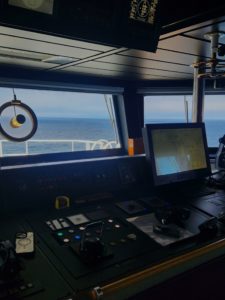
Today, we got the chance to tour the bridge, the central headquarters of ship operation. As we began to head up, it was a bit surprising to have to climb as much as we did. After nearly two weeks on the ship, you would think that I would have an idea of how big the ship really is but apparently, despite some areas beginning to feel more spacious, when it came to going upwards, it was much taller than I expected. After around 5 sets of stairs going up, we arrived at the bridge and once settled, we talked to Molly(chief mate), Mark(second mate), and Derek(the captain) and they gave us a rundown of the instruments and the day to day of bridge work. We learned how they drive the ship, navigate, adjust, and manage Jason dives. The three of them gave us great explanations of everything, and despite not having any knowledge of the instruments beforehand, by the end I felt like I actually somewhat understood the major parts of piloting a ship.
As we are beginning to wrap up our leg of the voyage, completing final dives, figuring out what the last day at the dock will look like, we are also starting to really solidify our ideas for projects. This includes writing a summary of the idea(s) we are having while they are fresh in our mind so that we can translate that over into an actual project to work with during fall quarter. Originally, I had planned to do a project about the structure of the water column and how it possibly affects species distribution. However, after taking the bacterial samples, I realized I could build a project off of that experience and possible research afterwards. Thus, I spent some of the quieter times today working on gathering photos and creating a project outline that I am really excited about.

I woke up today both very cold and with a fear of krill. Last night, we were meant to begin a 6 hour survey dive of Southern Hydrate ridge. At around 1am, despite some waves the Jason crew decided to get prepped for the dive so I headed to the van. However, right as we got the confirmation from the crew on deck and had powered on, one of the engineers stepped into the van to deliver some rather interesting news. Apparently, there were so many krill in the waters around the boat that the intake was completely clogged. So many in fact (gallons of them) that we had to stop operations and shut down generators on the ship in order to focus on removing all of the krill. Thus, the dive was cancelled, and I went to bed with dreams (more like nightmares) that the ship was sinking and filled with krill.
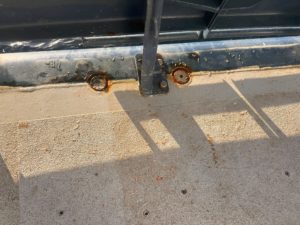
After the krill incident last night/early this morning, we ended up doing some unplanned transits that were a bit rougher than I expected. In order to escape the swarms of crustaceans, we traveled away from southern hydrate ridge to Oregon offshore, then after a quick dive in the morning, we headed back. Despite the delays we did manage to return successfully and complete our planned survey.
A survey to me is one of the most fun things to sit in the van for and observe. This was obviously a shared sentiment by the large crowd of people that sat in and watched even if they weren’t on shift. During the survey there was no replacing of equipment that needed to occur just imagery and video observing the area. This particular area is a methane seep site and so there were many different species found all over the parts we explored. We did a sweep of the area admiring creatures like rock fish, various crabs, and sea stars as well as several hagfish feeling their way across the sediment. It ended up being a really fun time (even if it was delayed) to sit with everyone in the van, chat, and take time to observe/enjoy the creatures.
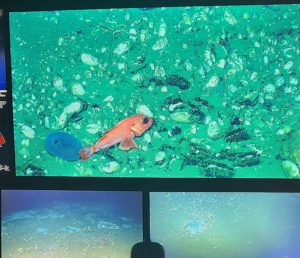
Finally, night rolled around with once again nothing much to do besides blog and puzzle. So, a group of us decided to go out onto the bow after getting a tip that there were “allegedly” good views of the stars. And thankfully it was not only alleged but very true. After a very dark walk up to the bow of the ship, we all stood and stared up at the clear night sky twinkling with thousands of stars. This was the first time I had actually gotten to see the stars on the boat and with the only light being the glow from the moon, the sights were incredible. We even caught a few shooting stars as well which is something I haven’t seen in years. The combination of the clear sky, rocking boat, beautiful sky, and cold, fresh wind was such a calming moment that really felt like I was cleansing my soul.

One of the highlights of today was getting to have a meeting with Derek Bergeron, the captain of the R/V Atlantis. We all gathered in the library, Derek at the head of the table, and we took turns asking our burning questions about what it is like to be the captain of this awesome vessel. From the day-to-day life of directing the ship to how he got started in this line of work, Derek answered all our questions thoughtfully and in depth. He even entertained us with some cool past stories and experiences he had encountered in his 24 years of being out at sea.
Sadly, despite previous cups of coffee, today’s did not work the way I expected it to. Unlike in the past where coffee would act as an easy pick me up when I was tired or feeling low, today it did the opposite. This left me not feeling up to do much of anything productive besides look at pictures of bacteria on some of the instruments we had surveyed and retrieved previously. Thankfully after a shower, cold water, and some down time I was able to recuperate a bit, but it didn’t stop me at the end of the day from feeling somewhat drained.
So far on this trip, we have seen many amazing creatures. One particularly memorable moment was during a Jason dive (J2-1709 to be exact) where the objective was to find a buoy and attach a beacon to it. To find the buoy in the dark waters, the Jason team used sonar to get an idea of the direction to go. Through the darkness something began to slowly emerge which everyone assumed was the buoy since it appeared on the sonar. As we grew closer, the team in the van debated whether it was the buoy or not since it was large and had similar coloring. However, much to everyone’s surprise, instead of a piece of equipment, it was actually a massive, brightly colored jellyfish.
The tentacles of the jellyfish were flowing upwards in a cloud of orange and yellow like a scrambled egg suspended in water. Within those tentacles swam three small, silvery fish, each one like a different sized copy of the others. I and the rest of the people in the van marveled at the size of the creature and its body structure in the water as it rippled within the current. It was identified as likely being a lions mane jellyfish swimming upside down. Seeing it appear slowly into view through the dark waters and be illuminated by the ROV lights was one of the coolest things I have seen so far on this trip.
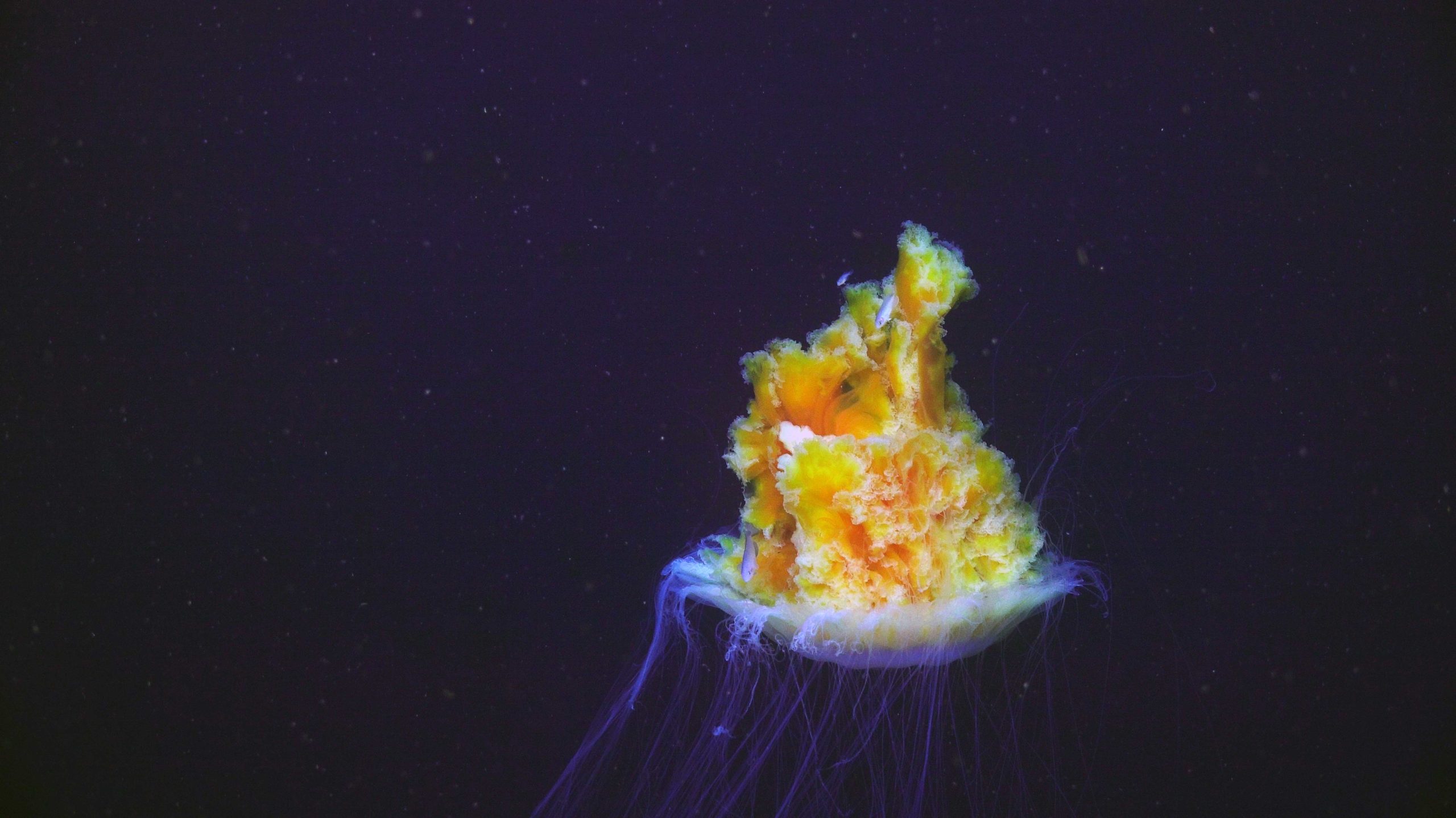

August 10th, 2025:
Today was the first day of more intense weather and the waves were much higher than before. I found that the ship was not only rocking back forth, but at other angles as well, so as much as I tried, no position while standing was stable for long. Despite this, however, I feel like I was able to slowly figure out how to manage movements, so I don’t totally topple over every time the ship tilts.
Last night was once again a shift with little to do, but because I didn’t want to fall out of my routine right as I was getting into it, I decided to stay up and find something to occupy myself. This ended up researching bacteria and their features. While it was a surface-level knowledge dive into the world of bacterium, it took up much of the 4 hours shift, leaving the last bit of time to just color some strawberries in a coloring book.
Since it was mostly a transit day with no work besides finishing blogs, in the morning Emily and I went to the galley to see if Ashley and Ben needed help preparing anything. They didn’t have much for us to do, but we did end up storing some various herbs to be used later in the trip. While we wrapped parsley and dill in paper towels and stripped thyme sprigs, we chatted about things such as cool birds and creatures we liked or places on the UW campus. Plus, as people cycled through the mess area, grabbing coffee, water, and snacks, everyone made sure to jump on the chance at making thyme puns which made the activity even more enjoyable. You could say we were really having a great “thyme”
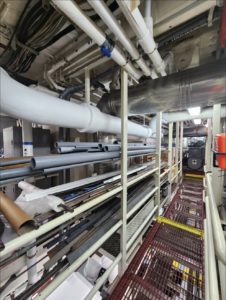
During the quiet of the day, after lunch a group of us were given a tour of the engine rooms by First assistant engineer Greg. He explained, in summarized terms, what the main pieces of equipment were, what the engineers did, and what it took to run such a big ship (such as amount of fuel and types of motors). It was really fascinating to learn about the inner workings of such a large vessel and to see the power behind such a large vessel.
With the conditions currently, we are in a “weather hold”, meaning we must wait for the weather and waves to clear enough before Jason can safely dive. Therefore, with nothing planned, a group of us decided to play some games in the library, something we hadn’t had the time or opportunity to do before. We played many different games including a crazy version of multiplayer-solitaire and cribbage. I also attempted to learn a bridge card shuffle (the kind of shuffle where you bend the cards to form a bridge and let them fall back down into your hands) and even after many attempts, I still couldn’t really manage it. I would like to say it was the cards that let me down, but it may have been the fact I couldn’t keep my thumbs down on the cards, which is apparently crucial in executing that kind of shuffle. Overall, while the day was much quieter than most people would have hoped, we still managed to make it into an incredibly fun time where we could hangout, laugh, and play games.
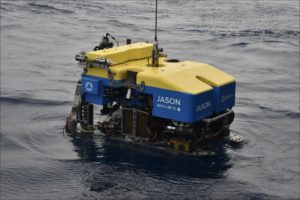
My midnight shift today was about as uneventful as it gets. I spent most of the time editing my blog, choosing pictures to resize and copy, trying to reach a reasonable word count, and making the sentences sound like an adult human not a 5-year-old child wrote them. After around an hour and a half of sitting and doing this with nothing but the sounds of waves rocking against the ship and the hum of the air conditioning throughout the main lab, I attempted to find something to do. The only thing ended up being to walk around with Alex and try to find things to tie down. This is how I discovered I did not actually know how to use a rachet strap despite having watched many people use them on the ship. After Alex gave me a very patient tutorial (since it was midnight my neurons were not firing very quickly), we managed to secure the last few major things that could be tossed about during periods of rough waves.
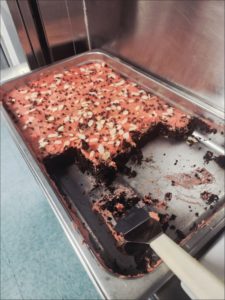
After midnight passed and my shift ended at its usual 4am, I headed to bed, determined not to miss breakfast again. And with some amount of luck, I was finally able to hear my very first alarm and wake up, a feat that I fear may never be repeated. Breakfast included an amazing berry cheese Danish that I was so glad I didn’t miss because I am still thinking about it now. The baked goods like that Danish that Ashley and Ben prepare are one of the things I most look forward to on the ship. And yes, I know I say that about a lot of the meals on the ship, but nothing can beat a slice of cake leftover from dinner time when you are about to head to a late-night shift in the van.
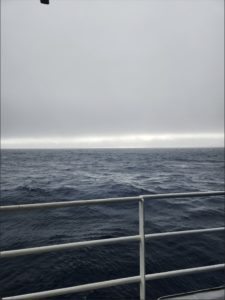
The most interesting event of the day was the first major delay in diving due to a technical issue. When I awoke from a much needed 5-hour sleep following breakfast, I expected to head straight back into diving work but instead I was met with news that Jason was going to be delayed for likely an hour or more. One hour passed, then two, and then finally at 3 pm, thanks to the Jason crews’ efficient work, it was diving time once again. The first couple of minutes were a bit more tense as everyone continually checked the instruments to make sure that Jason wouldn’t lose power. Thankfully, everything went smoothly, and all goals were able to be accomplished despite that initial setback.
Something no one is looking forward to now is the promise of bad weather for the next two days. We were informed that during our around 20-hour transit the waves could reach up to 9 feet (3m) much to the dismay of some of my more sea-sick prone ship mates. You would think that I would be worried about such strong weather and the likelihood the ship will be rocked quite extremely but so far, I am not nervous about it. That being said, it could very well turn out that I may eat those words (or rather throw them up) and regret ever daring to think I could withstand bad weather out on the open seas but only time will tell.
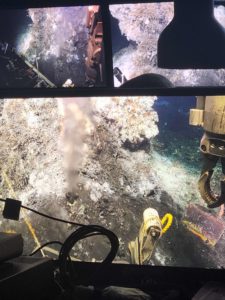
August 8th, 2025
I slept much better after my midnight shift last night thankfully and though I missed breakfast, Nadia (my roommate and fellow visions student) was incredibly kind and saved me fruit and a breakfast sandwich. After eating, I headed to the Jason van where we had finally arrived at the place we had all been waiting for; the ASHES vent field at the summit of Axial Seamount. Entering the dark van, I was greeted with images of the Mushroom edifice with 324°C fluids pouring out of a small vent at its base into the deep ocean water. This moment was something I had been dreaming about since I learned of the VISIONS cruise during winter quarter last year in Dr. Kelley’s class.
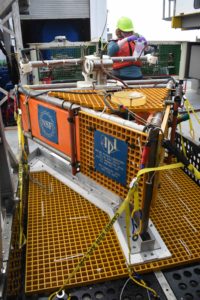
Watching video of the vent field from the van, while knowing that the images on the screens were occurring just below us was so humbling. I have been in love with the ocean and specifically the deep ocean for years, but I never thought I would have the chance to be on a trip like this even before I had finished my undergraduate degree at UW. So, moments where the reality sets in that I am actually here, looking at these hydrothermal vent sites, really makes me feel so thankful to have this opportunity.
One new experience today that has been one of my most memorable/exciting so far has been taking bacterial samples off equipment that was recovered from ASHES. When we were in the van observing the dive, we saw thousands of strands of filamentous bacteria covering cables and instruments on pieces of equipment in the vent field. Watching the strands dancing in the current was mesmerizing and so far, I believe that has been my favorite organism we have seen. There is something about the texture, color, and structure of the bacteria that makes me want to watch it dance about for hours.
As camera installed last year was recovered with bacterial biofilms, Lacie Levy, the VISIONS graduate student, mentioned the possibility of scraping some of the bacteria off recovered instruments. This got me very excited because I am fascinated by the bacteria and the possibility of analysis if the samples survive. When I voiced this, Lacie was incredibly kind and let me take the samples by myself after some guidance. At first, I was afraid of messing it up and when I began sampling, the fear grew a bit since it was much harder to scrape the bacteria off than I expected. But after a bit of time, I was able to secure as much bacteria as I could, placing it in tubes, recording it’s location, and then placing it in the –80° C fridge. Of course, there is no guarantee of the success of these samples, but just being able to take them was absolutely incredible and I am so grateful to Lacie and everyone else for giving me that opportunity.
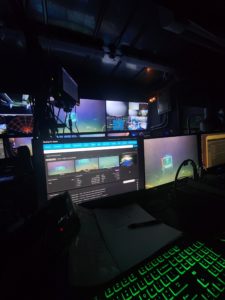
August 7, 2025
Somehow even after setting four different alarms, I still managed to sleep for slightly too long today. When my midnight shift rolled around, instead of being in the van 15 minutes early as I should have been, I was still half asleep in my bed, unsure what day, time, or year it was. After Alex had to come wake me up, I quickly got ready and managed to only be 5 minutes late, which I still felt quite bad about. As I made my way to the van to my shift, I pondered how I could have managed to miss so many alarms. In my 5 minutes of frantic preparation, I determined I must have heard the first alarm and accidentally shut off the rest in my sleep. It’s safe to say that I will be setting my alarms even earlier from now on, just to be sure.
As soon as I entered the van, I jumped into the camera position and began working. When manning the camera station, you have several jobs: monitor the cameras, take pictures, and manage the feeds being recorded by the different cameras. After checking the various feeds, making sure everything was coming up green and the cameras were working and correct, all that was left to do was sit and watch during the ascent, which went rather smoothly. After Jason was safely on deck, I switched seats to finally try the SeaLog position where we log actions taken by the ROV and the Jason team. While I was nervous at first, during the next dive that occurred shortly after, I felt as though I was able to catch on rather quickly and it ended up being really fun.
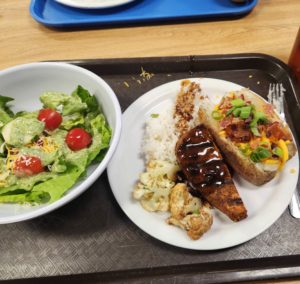
One of the coolest things on the ship has been meeting all the people onboard and learning about their stories. For example, today we met with Ben Meyers, one of the cooks in charge of making incredible meals on board. Ben told us about his time on schooners and tall ships as well as the many different restaurants he had worked in before eventually making it to the R/V Atlantis. It was so awesome to be able to talk to Ben who has been not only an awesome cook but also just a positive person. He learns everyone’s names so quickly and always asks you how your day has been when you’re grabbing a meal which always makes me smile.
Truly, I could spend much of this blog talking about the food that Ben and Ashley (the steward on board) create, but I fear that would not make a very good blog about a scientific cruise. While I did not expect the food on this cruise to be bad, I’ve been surprised by how delicious each of the meals has been. From seared tuna and baked potatoes to lobster rolls and French fries, the food is clearly made with care and attention that it makes any sad or overwhelming time so much brighter. These moments of calm where we can sit down and enjoy great food have really helped keep me sane for these first days on board.
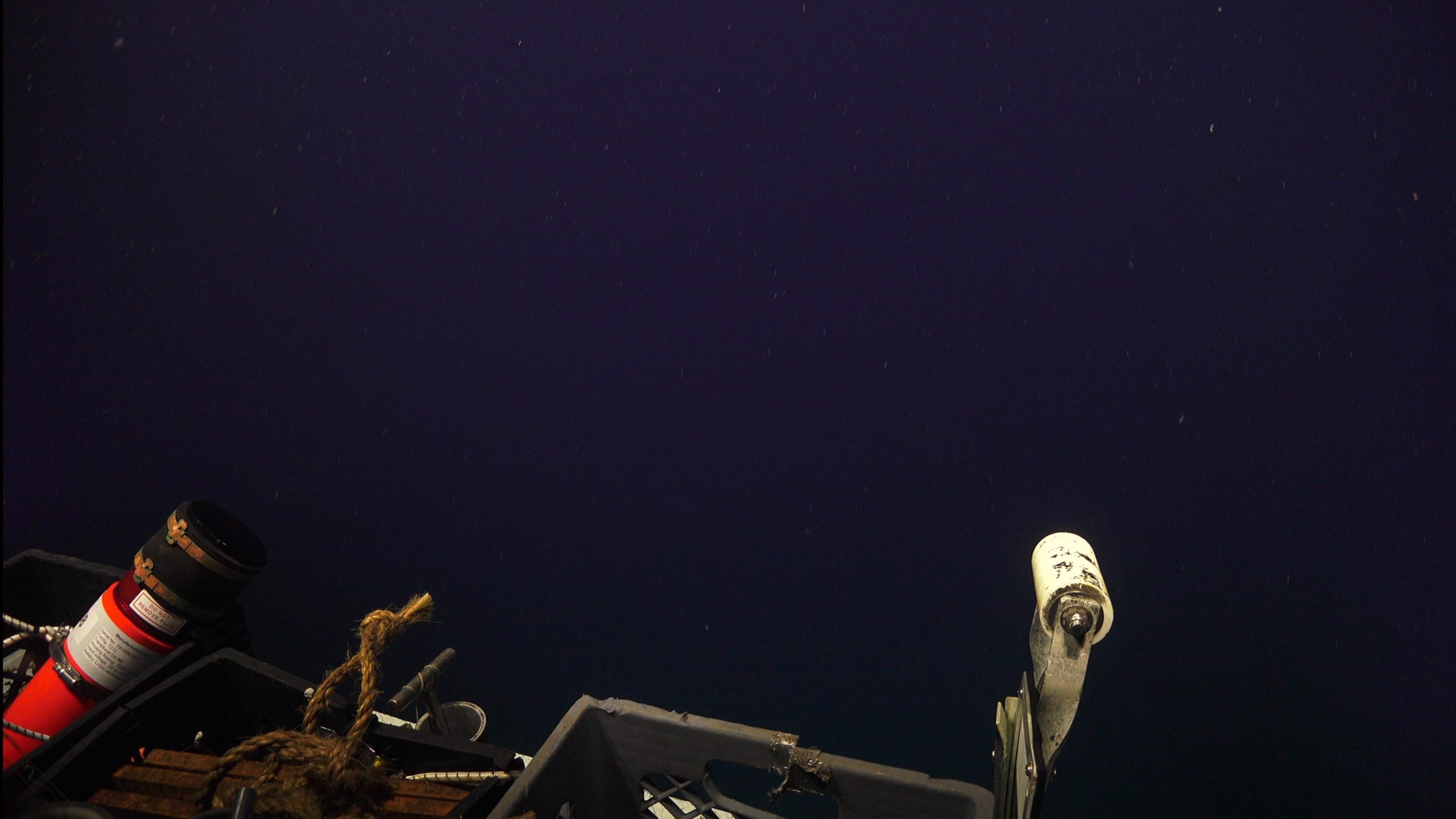
August 6, 2025
My shift today started at 12am, an early hour I am still adjusting to. After dinner ended at 6 pm on the 5th, it was off to bed for around 4-5 hours before the midnight hour arrived and the time to go back to work. As I have lain in bed at night, I find it hard to drift off despite how much I know I need to. No amount of wishing myself to sleep can seem to force my brain off as it races with a million thoughts.
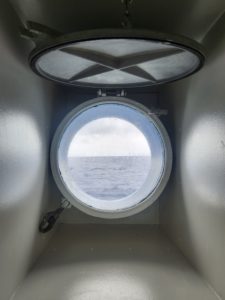
In one of my most recent attempts at sleep, of the 4 hours I had planned I believe I managed around 2. Despite this, when that 12 am hour struck it was off to the Jason van. The following 2.5 hours consisted of lots of sitting and watching dark water pass by as Jason ascended around 2900 meters back to the surface.
My shift mate Lacie and I admired the occasional jelly or salp that would float its way through but beyond that it was mostly a time to vibe to music and listen to the occasional conversation being had by the Jason team.
After Jason had been set on deck and secured, I made my way back downstairs, settling in just as the next transit began. The first couple of transits have been relatively calm and around 5 hours or less, but this transit is going to take around 20 hours with much rougher seas. As I sat at my desk in the Main Lab as we began cruising along, the ship rocked back and forth much like a seesaw being controlled by an excited child. I could feel each swell and fall, my seat shifting slightly beneath me with each up and down motion. It is times like these that I am so grateful I do not get seasick because these movements would probably leave me bedridden.
During transit today, our main jobs as VISIONS’25 students appeared to be either A) rest if you are feeling seasick or B) work on blogs and projects. There was not much to do during our normal shifts besides be awake or at least attempt to be. Of course, since you are reading this, I have been working on my blog, but when I am not writing these thrilling narratives, I am brainstorming ideas for projects. Since I am a marine biology and oceanography double major, one of the things I am most interested in is studying a combination of both fields. This means observing how the more physical things like pressure, depth, chemistry, etc. affect and drive biological distribution.
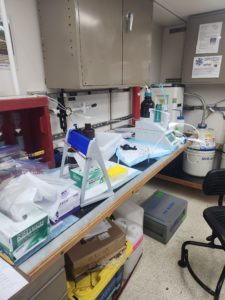
I am still in the early stages of drafting my project, but I have been thoroughly investigating the data I have to work with so I can create a more solid vision of what I want to do.
One of the most interesting things that I took part in today was observing and helping co-chief scientist Mariela White conduct Winkler titrations. This process of measuring dissolved oxygen concentrations involved taking prepared water samples that had been taken from a CTD on an earlier day, performing a Winkler titration with the proper tools, and then recording the amount of titrant (a solution of known concentration used to determine oxygen concentration in the sample).
Though repetitive, I found recording the numbers and washing the glass vials after the titration was complete to be incredibly fun. Mariela and I were able to chat about life, school, and project ideas, which made the time pass by quickly. The experience of being able to watch the direct application to the real world of a method (Winkler titration) that I had only learned in class was fascinating and made me only more curious about the further applications of the data we are collecting.
August 5th, 2025
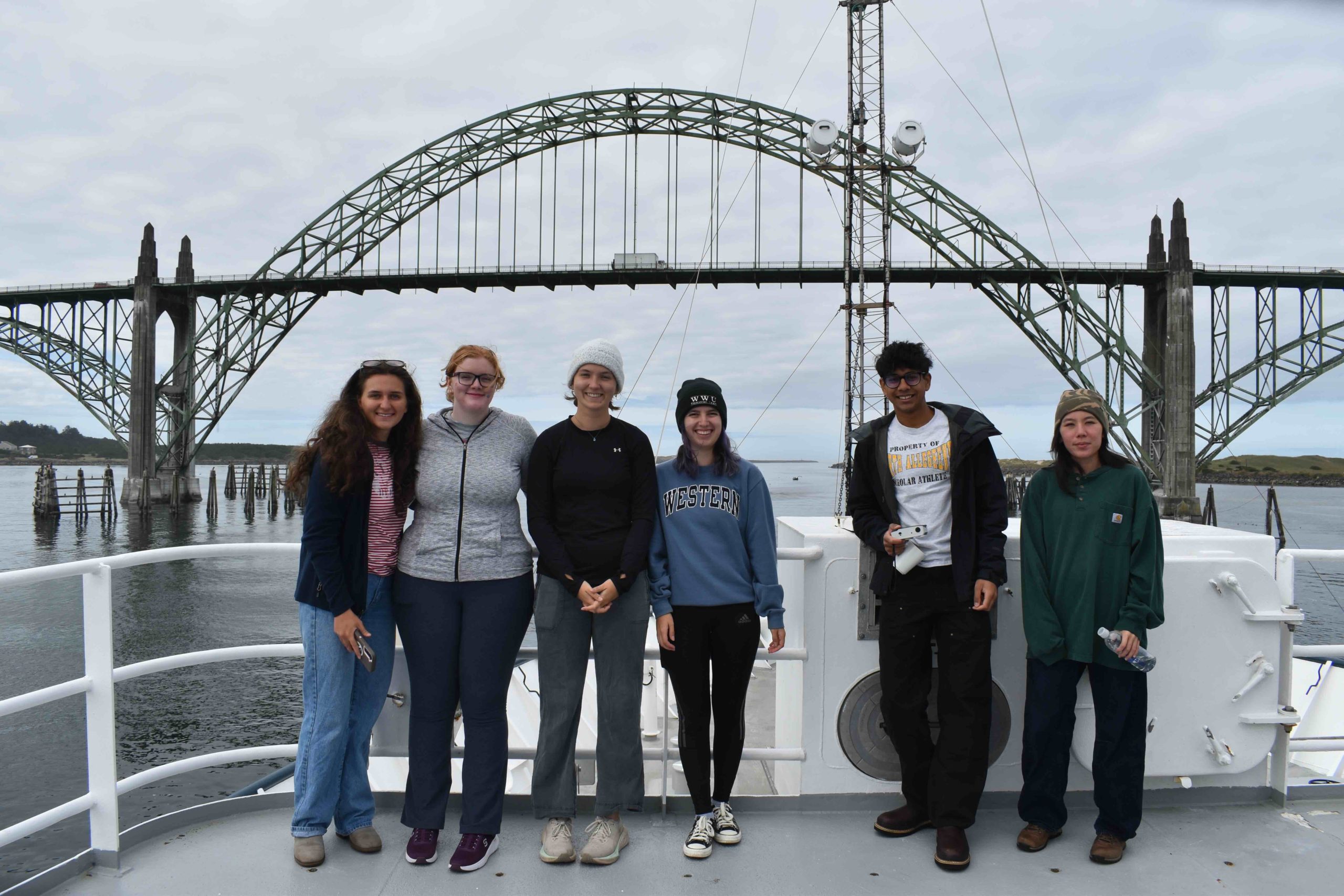
Credit: M. Elend, University of Washington, V25
Today started off a bit rough as I slept through the best meal of the day, breakfast. Though disheartening, it was an obstacle easily overcome with some almonds and the hope of lunch being not too far off. After taking my first ever shower on the ship (a task that ended up being much easier than I expected) I headed out and jumped straight into work. After heading upstairs, I peered out the window of the main lab, observing the recovery of the second round of CTD samples. Then it was off to the wet lab to begin sampling the water that had been collected.
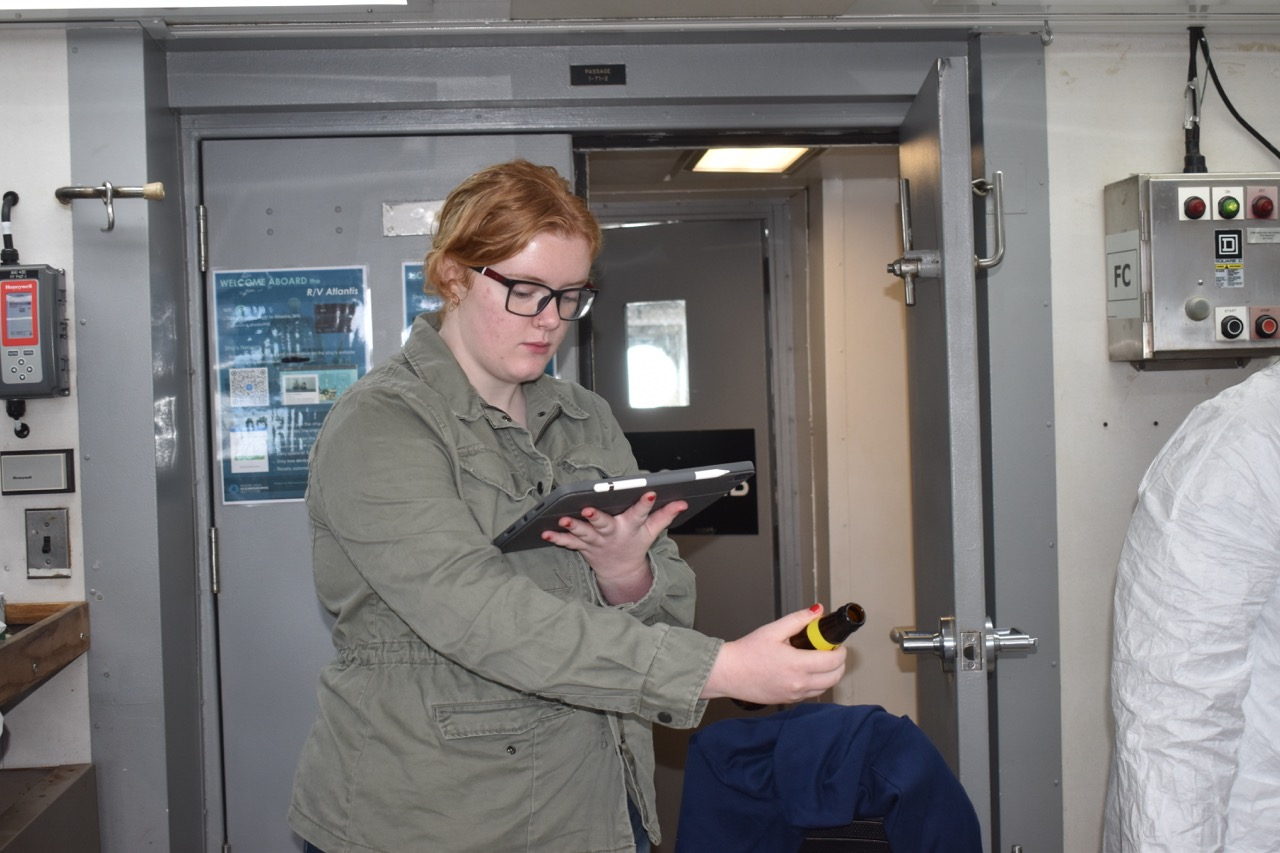
The wet lab is a relatively small and simple space since on a ship you don’t really have the room or resources to have massive, advanced labs. Despite its cozy, rudimentary appearance however, working in this lab makes me feel like the fanciest scientist on the planet. This round of samples included everything from oxygen, DIC (dissolved inorganic carbon), and salinity. We took turns writing sample numbers, scanning barcodes, and taking physical samples from the Niskins (the bottles that hold the water on the CTD). I got to use an iPad to scan in the samples and it was funny because it felt like I was taking orders at a restaurant even though you definitely did not want to consume anything present in that lab.
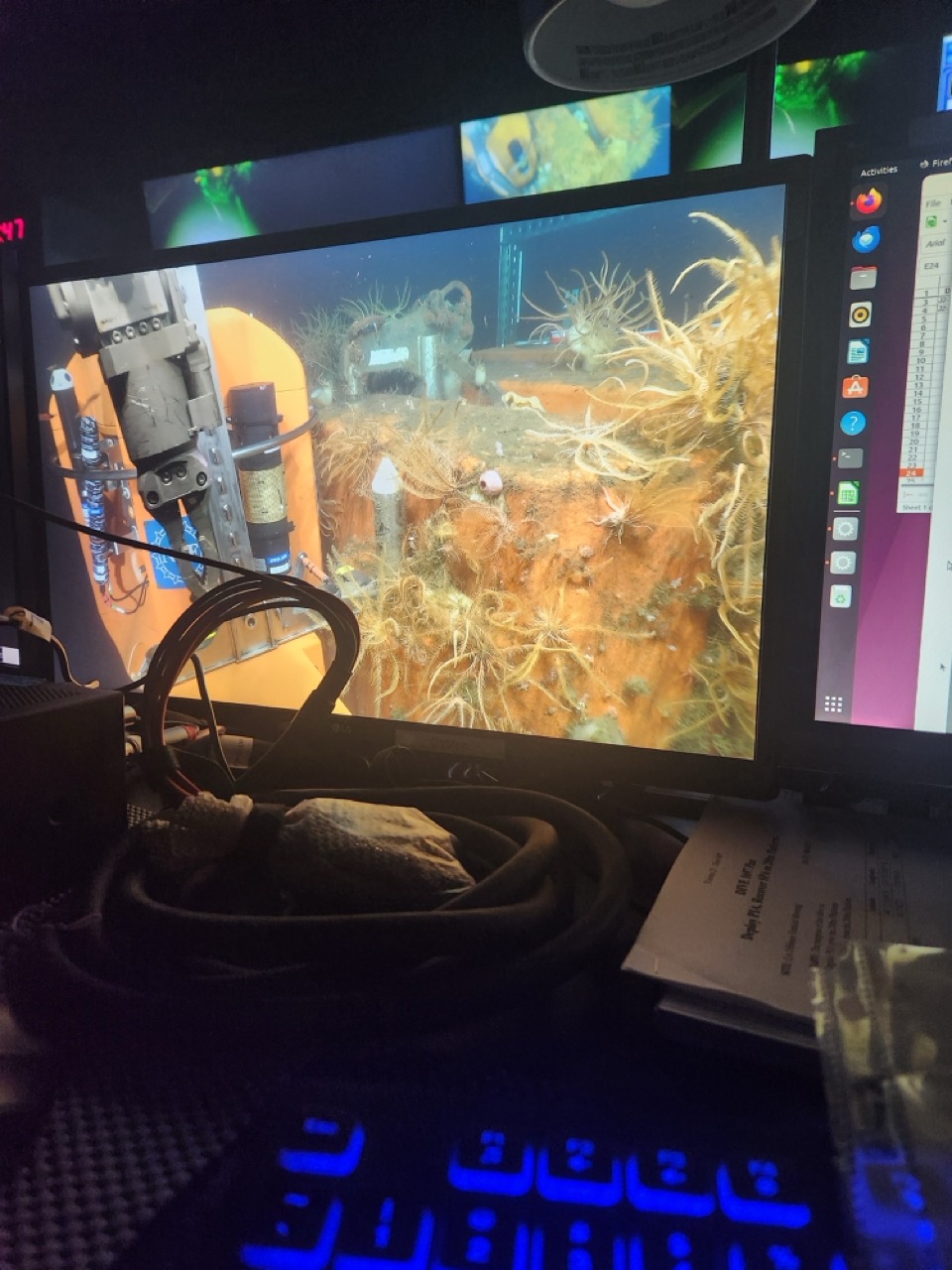
Throughout these 2 days on the ship, I have met many passionate and kind people. From the science and Jason teams to the crew, I have been working hard to become acquainted with everyone and remember their names. In this endeavor, I have been surprised by just how welcome I have felt in each of the spaces on the boat. I didn’t enter this trip thinking that I would be surrounded by mean or grumpy shipmates, but the kindness people have shown us has been even more encouraging than I expected. Whether they are answering our questions earnestly and without judgement (even if the questions feel simple or repetitive) or asking how we are feeling during our first trip to sea, the people around us have been incredibly kind which has made the experience much less overwhelming.
One of my favorite places onboard the ship right now is the Jason van where we have our shifts running the camera and Sea Log during Jason dives. Walking inside the dark, frigid van for the first time was a bit scary but after settling in the experiences in the van are incredible. The bright glow of the dozens of screens while witnessing the process behind these dives creates a vibe like no other. I remember seeing video stream of the inside of these kinds of vans when I was younger but to actually be in the room myself has been inspiring. I can’t wait to continue to help with and experience these dives as we travel further from shore.
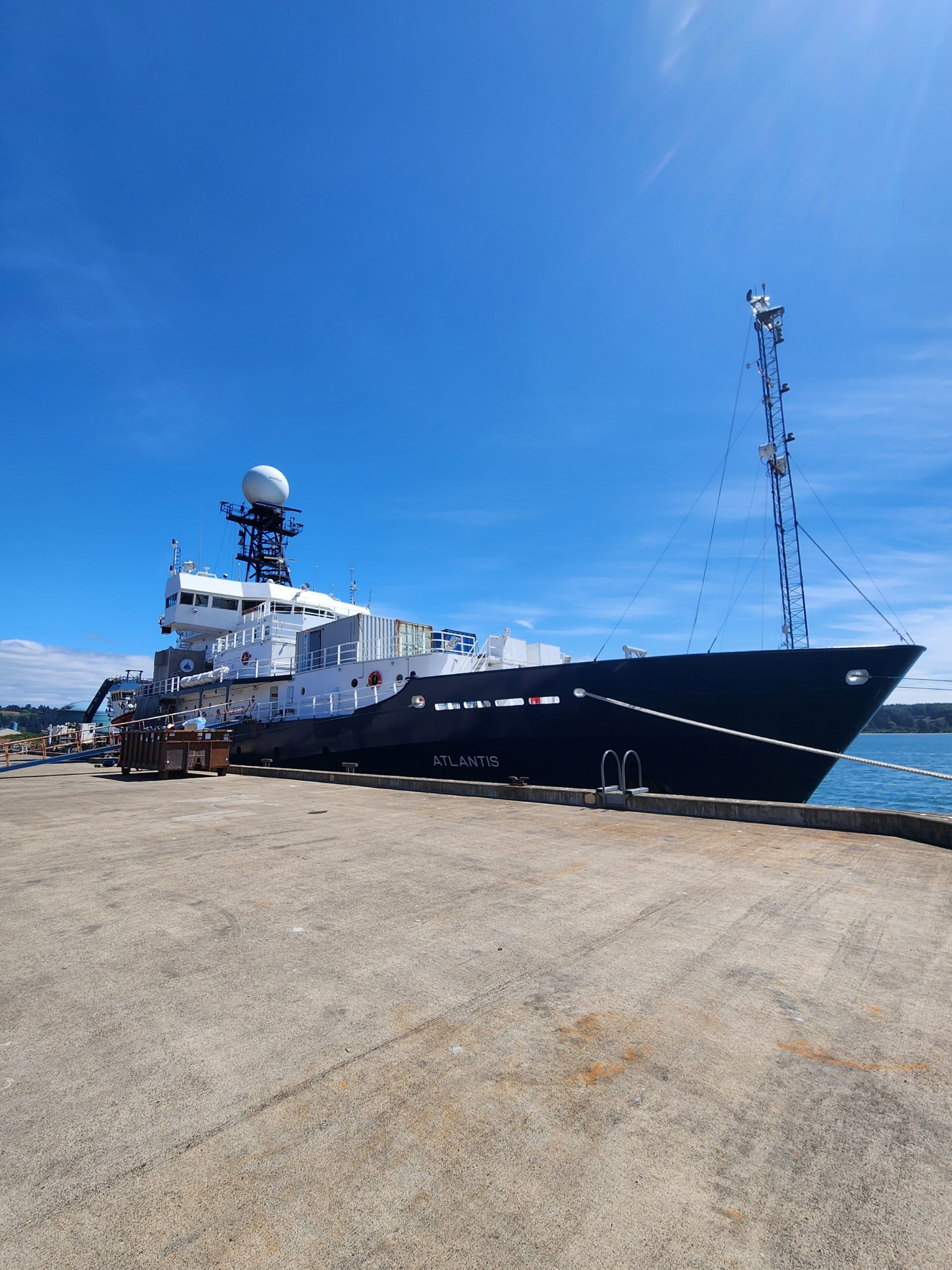
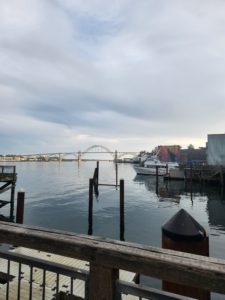
August 4th
We arrived at the ship yesterday and I was admittedly quite tired and nervous about what to expect. After a 6-hour van ride where my fellow visions students and I discussed research, our feelings about the trip, and just life in general, we descended a steep hill into the port. Stepping out, inhaling that first breath of salty air, we approached the looming vessel before us. The feeling was surreal being able to finally climb the gangway after months of preparation, feet scraping against the metal pathway while listening to the melody of the systems humming deep within the boat.
This being my first time on a large-scale research vessel, I had some ideas of what the cabins and spaces would be like after seeing videos and pictures, but I still wasn’t fully prepared for how spacious the cabins would feel. While getting situated in my cabin I was surprised by how much space there was to move about and place my items in, even with a roommate. Of course, as I unpacked, I left my snacks in an easy to reach location in case I needed to grab a quick pick me up before heading out to my shift.
The following hours seemed to move by quickly as we departed the ship to find our last dinner on shore. A group of us VISIONS’25 members wandered for around 1.5 miles into downtown Newport where we found a great Thai place to eat before heading back. On the way back to the ship, we made a couple stops such as a candy shop where a kind lady gave us some free saltwater taffy as well as a stop to admire some rather vocal sea lions as they fought for the best spot on the rocks. Finally, as the sun set, we climbed back onboard, snapping some beautiful pictures of the ship against the glowing sky.
Night one on the ship was somewhat uneventful though I did wake up just about every hour flipping back and forth each time. At 7 am the next morning I officially awoke and got ready in silence (as my roommate got a bit of extra sleep), which ended up being oddly soothing. Being silently alone with your thoughts on a ship you are about to set sail on for two weeks is a rather overwhelming reality, but having that moment to breathe made it seem more manageable.
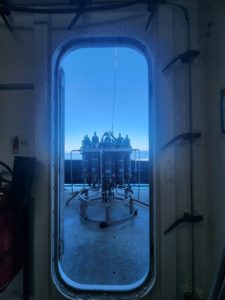
After a quick but delicious breakfast of lemon poppyseed pancakes, the following hours were a whirlwind of safety, prep, and demonstrations. Between the first safety meeting where we donned thick rubbery survival suits, Jason orientation, and CTD training, we learned everything from water evacuation to bowline knots. To be frank, it was incredibly daunting being faced with so much information at once and I found myself fighting to keep my brain from giving up. Despite this, I am determined to take those feelings of being overwhelmed and use them to fuel myself throughout this journey to get increasingly better at my responsibilities. So, while it may take a moment to adjust, I am so excited to continue working and learning!
